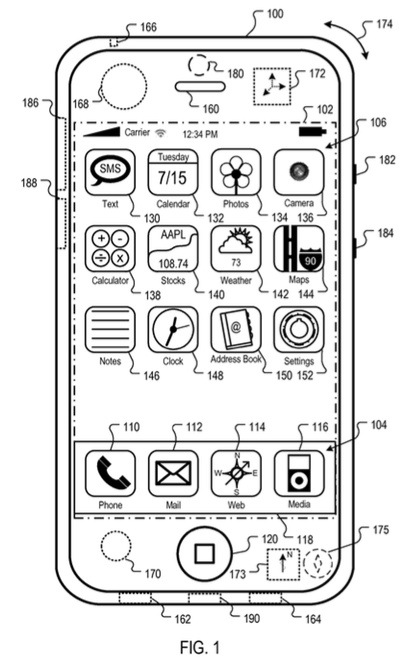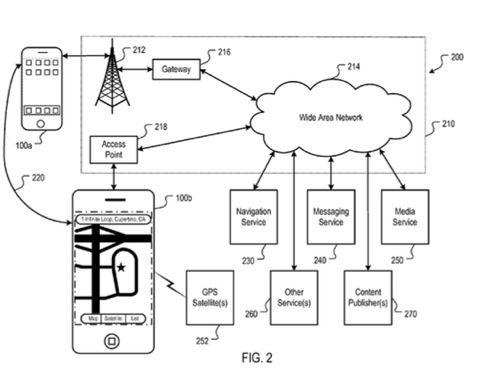Apple has filed a patent (number 20120225677) with the U.S. Patent & Trademark Office for synchronizing mobile and vehicle devices -- especially in regard to mapping features.
Per the patent, location information is received at a mobile device from the memory of a vehicle device. The mobile device is updated based on the location information. Sensor data is received from at least one sensor measuring movement of the mobile device, and an estimated location of the mobile device is calculated based at least in part on the location information and the sensor data.
Here's Apple's background and summary of the invention: "The role of traditional printed maps is being supplanted by modern devices capable of rendering dynamic map displays. Devices that include mapping or navigation applications provide information regarding an area selected by a user by recalling map data from local memory or networked services.
"Mapping devices include appropriately configured personal computers as well as dedicated mobile devices, including those found in automobiles, aircraft, and watercraft. Newer mobile devices may integrate mapping features with one or more other functions previously found only in stand alone devices, such as computing functions, personal data assistants, cellular telephone service, network access, camera functions, and the ability to play media files and games.
"Mapping devices often include the ability to provide directions from a point of origin to a destination. When coupled with any of a number of positioning technologies, a mapping device can display a current position on a map as well as deliver navigation instructions based on the current position to route a user to a desired destination. Positioning technologies include satellite positioning systems such as GPS, information from nearby cellular base stations, information from other mapping devices, and information from other transmitters, such as IEEE 802.x or Bluetooth transmitters, having known locations.
"According to one aspect, there is disclosed a computer-implemented method. The method includes receiving, at a mobile device, location information stored in a memory of a vehicle device, and updating a mobile device based on the location information, where the mobile device is proximate to the location of the vehicle device. The method also includes receiving sensor data from at least one sensor measuring movement of the mobile device, and calculating an estimated location of the mobile device based at least in part on the location information and the sensor data.
"One or more of the following features may also be included. The vehicle device can include a GPS system and/or a GPS receiver. The at least one sensor can be located within the mobile device, and can be an accelerometer, gyro, and/or compass. Additionally, the mobile device can be in communication with the vehicle device during the updating of the mobile device. The mobile device can be in communication with the vehicle device via a wireless communication and/or via a communication link. Additionally, the location information can include the current location of the vehicle device, the location of a desired destination, the location of an object, or navigation information.
"According to another aspect, there is disclosed a computer-implemented method. The method includes transmitting to a vehicle device location information stored in a memory of a mobile device, and updating the vehicle device based on the location information, where the mobile device is proximate to the location of the vehicle device, and where the location information is accessible to a user via at least one interface with the vehicle device.
"One or more of the following features may also be included. The vehicle device can include a GPS system and/or a GPS receiver. The method can also include comparing the location information to vehicle device data prior to updating the vehicle device based on the location information. Furthermore, updating the vehicle device based on the location information may occur after a determination that the location information does not exist in the vehicle device data. The mobile device can be in communication with the vehicle device via a wireless communication and/or via a communication link. Additionally, the location information can include the identity of an object, the identity of a geographical location, the geographical location of a desired destination, the geographical location of an object, or navigation information.
"According to yet another aspect, there is disclosed a computer-implemented method that includes transmitting to a vehicle device contact information stored in a memory of a mobile device, and updating the vehicle device based on the contact information, where the mobile device is proximate to the location of the vehicle device, and where the contact information is accessible to a user via at least one interface with the vehicle device.
"According to a feature, the contact information can include a telephone number, an address, a name, and/or an email address.
"According to another aspect, there is disclosed a portable electronic device. The device includes a touch sensitive display, one or more processors, a memory, a motion sensor, and a program. The program is stored in the memory and configured to be executed by the one or more processors, and the program includes instructions for calculating an estimated current location of the device, the calculation being based at least in part on location information provided by a vehicle device and received sensor data from at least one sensor of the portable electronic device.
"According to yet another aspect, there is disclosed a method of coupling a first device to a second device, where the first device is proximate to the second device, updating the first device with location information from the second device, and calculating an estimated location of the first device based at least in part on the location information from the second device. The second device can also be updated with location information received from the first device."
The inventors are Scott Forstall, Gregory N. Christie, Robert E. Borchers and Kevin Tiene.














